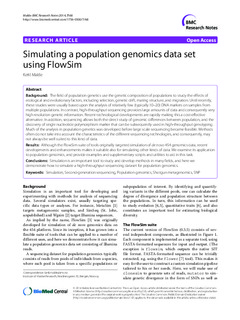Simulating a population genomics data set using FlowSim
Journal article, Peer reviewed
Permanent lenke
http://hdl.handle.net/11250/194942Utgivelsesdato
2014-01-31Metadata
Vis full innførselSamlinger
- Articles [3011]
Originalversjon
Malde:Simulating a population genomics data set using FlowSim. BMC Research Notes 2014 7:68. 10.1186/1756-0500-7-68Sammendrag
Background
The field of population genetics use the genetic composition of populations to study the effects of ecological and evolutionary factors, including selection, genetic drift, mating structure, and migration. Until recently, these studies were usually based upon the analysis of relatively few (typically 10–20) DNA markers on samples from multiple populations. In contrast, high-throughput sequencing provides large amounts of data and consequently very high resolution genetic information. Recent technological developments are rapidly making this a cost-effective alternative. In addition, sequencing allows both the direct study of genomic differences between population, and the discovery of single nucleotide polymorphism marker that can be subsequently used in high-throughput genotyping. Much of the analysis in population genetics was developed before large scale sequencing became feasible. Methods often do not take into account the characteristics of the different sequencing technologies, and consequently, may not always be well suited to this kind of data.
Results
Although the FlowSim suite of tools originally targeted simulation of de novo 454 genomics data, recent developments and enhancements makes it suitable also for simulating other kinds of data. We examine its application to population genomics, and provide examples and supplementary scripts and utilities to aid in this task.
Conclusions
Simulation is an important tool to study and develop methods in many fields, and here we demonstrate how to simulate a high-throughput sequencing dataset for population genomics.
